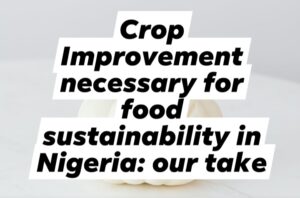Despite being the world’s largest producer of cassava, Nigeria continues to experience shortage of food and other basic necessities of life. According to World Food Program’s declaration, the effects of Covid-19 pandemic on the country’s farming sector is set to further aggravate the level of food insecurity beyond 2020 which means there could be an intense shortage of food throughout the land.
Considering the predictions, it is more than necessary that the country finds a perfect way of improving the level at which food crops are being produced across the country. Luckily, there is a perfect way to go about it and that’s engaging in crop improvement practices.
What’s Crop Improvement?
Contents
Crop improvement simply refers to some of the actions and procedures taken by experts, scientists or botanists which are aimed at improving the features and overall quality of a plant or crop.
In other words, crop improvement can be defined as the transfer of laudable and impressive traits and features from one plant to another in order to improve the productivity of all the plants in the farmland.
This includes studying the genetics, psychology, taxonomy, physiology and anatomy aspect of plants in order to successfully transfer traits between plants of different kinds and species for better and higher crop production.
Why Crop Improvement Is Needed In Nigeria
The importance of Crop Improvement to Nigeria farming sector can’t be overlooked by farmers and experts. This is because it plays a huge role in helping the country have access to good and quality crops. Other importance of crop improvement is discussed below:
1. It Ensures High Productivity:
Crop Improvement leads to an increase in plants’ productivity and quality as it gives room for the transfer of good traits from one plant to another which will eventually lead to production of food crops that will stand the test of time.
2. It Aids Multiplication Of Desired Traits:
With Crop Improvement, a farmer has the opportunity to multiply the desired features in one plant as he can easily transfer these features to other plants. This practice can be repeated until all his or her plants possess one or two desired traits.
3. It Enhances Crop’s Ability To Resist Outbreak Of Pest and Diseases
Apart from helping farmers multiply the desired traits among the plants in their farm, crop improvement also help in preventing crops from getting damaged too easily by pest and diseases.
This is because it ensures that the plants have huge strength to withstand pest, diseases and unfavorable climate change.
How To Improve Your Crop
There are two major scientific ways to carry out crop improvement or plant breeding. They include genotype and phenotype improvements.
Genotype Crop Improvement
This is that type of crop improvement in which genetic features of one plant are being transferred to another for proper or higher yield and productivity.
Impressive traits can be transferred from one generation to another generation through this method of crop improvement.
Step-by-step Guidelines On How to Carry Out Phenotype Crop Improvement In Your Farm
To successfully carry out this method of crop improvement, you must accurately undertake some procedures which are discused below:
A. Introduction
Plants or Species that possess the desired qualities and features must first be introduced into an entirely new environment where their traits are needed. This simply means importing plants with quality traits into your farm where further procedures will take place.
However, you must endeavor to conduct series of tests on the plants to ascertain that they are free of all kinds of disease or infections before progressing to the next breeding phase.
B. Selection
This is an artificial procedure in which plants with the highest level of productivity are being separated from the ones with lesser productive rates.
Also regarded as selective breeding by some experts, this stage of crop improvement requires you to separate the best plants from their species so as to transfer their features to your own species of lesser quality.
It is important you know that this process won’t lead to creation of a new breed, but it will definitely increase offspring’s overall quality and productivity.
C. Hybridization
This is another step you should take if you must successfully improve your plant or crop. Hybridization involves the transferring of heritable characteristics from one plant to the other through the merging or fusion of female and male gamete.
This is mostly done by farmers who want a trait to be transferred from parent of a particular specie to the offspring of the same specie.
D. Cross-breeding
This procedure is another way by which you can improve the quality of your plant. It involves the transfer of pollen grain of a high quality plant to the stigma of a plant with little or no desirable features.
It is advisable to explore this method if you are interested in transferring features like high resistance to drought; harsh or unfavorable weather conditions; and diseases.
2. Phenotype Crop Improvement
Here is the second major scientific way of improving your plant’s physical characteristics. This method largely focuses on agronomic practices in order to help bolster the physical characteristics of a plant.
This method includes plant transplanting, nursery, conservation of soil nutrients, planting of crops in their due season etc.
Conclusion
As much as engaging in any of the two methods will surely increase your crop’s productivity, it is extremely important you maintain complete accuracy while carrying out the discussed processes because a slight error might destroy your plant.
Conclusively, it is advisable you deploy the two — Genotype and Phenotype— methods as they will definitely work together to great effects on crop.

We remain a trusted and reliable source of information as regards career, employment, payroll management and lots more.We have been featured in numerous and popular websites including
Crunchbase, Glassdoor, Craft, Medium, Facebook, the Guardian,Twitter and lots more
